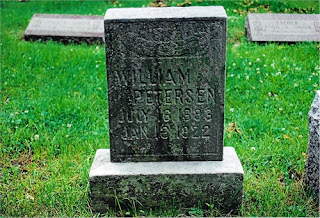This week's post is in honor of National Police Week, and in memory of Officer William Petersen.
 |
| Officer William Petersen on his Harley Davidson, circa 1922. Courtesy of the Westerman Family. |
During Prohibition (1920-1933) bootleggers traveled from Wisconsin along Sheridan Road through Lake County, Illinois. In addition to the vehicle going over the speed limit, Officer Petersen may have suspected the occupants of the "blue touring car" of being whisky runners.
Petersen pursued the vehicle on his motorcycle (which he owned personally), chasing the car for five miles through Winthrop Harbor and the City of Zion. Just south of Zion near Sheridan and Yorkhouse Roads, George Pavlik, Lyle Fast and Melvin Jordan heard the sound of approaching vehicles and watched the chase.
As he drew close to the vehicle, Petersen yelled for the driver to stop. Just then a man wearing a Derby hat leaned out the back window with a shotgun and fired twice. Petersen was shot in the stomach, his motorcycle swerved into a ditch and he was hurled into a field.
The "murder car" drove away, and the onlookers ran to assist Petersen, and to telephone authorities in Waukegan.
Waukegan police said the register on Petersen's motorcycle showed that it had reached a speed of 72 mph in the chase.
 |
| Local farmer, George Pavlik (1898-1962) witnessed the murder of Officer Petersen. |
George Pavlik went with police to
On January 17, Petersen’s funeral was held in
On February 4, it was announced that three "foreigners" were arrested for Petersen's murder at Koller's Tavern at 1920 Allport Street, Chicago: John Bartole (driver of the car), Michael Radich, and Ignatz Potz. Previously, three other men were arrested and released.
The shooter, Ignatz Potz, a woodworker by trade and native of Hungary, was a member of a
 |
| Lake County jail where Potz was held for trial. The jail was built in 1895, photograph taken in 1952. LCDM Collections. |
Potz was detained in the
Potz was tried, found guilty and sentenced to death. The gallows were brought to Waukegan from Chicago
As preparations were underway for the hanging, Governor Len Small, commuted the guilty man’s sentence to life imprisonment. The governor initially stated that "important alleged circumstances not hitherto brought out had come to his attention."
During this time, Governor Small had his own troubles, he had been indicted for embezzling $600,000 from the state. On June 24, 1922, Small was acquitted of all charges, and later, eight jurors got state jobs.
In 1928, Governor Small pardoned Potz, who was released. Potz left Illinois for Los Angeles, California where in the 1930s he was working as an iron worker. Later that same year Governor Small was indicted for having sold an estimated 500 pardons. He never went to jail, but was voted out of office.
 |
| Invitation sent out by Lake County Sheriff announcing the execution of Ignatz Potz. Private collection. |
During this time, Governor Small had his own troubles, he had been indicted for embezzling $600,000 from the state. On June 24, 1922, Small was acquitted of all charges, and later, eight jurors got state jobs.
In 1928, Governor Small pardoned Potz, who was released. Potz left Illinois for Los Angeles, California where in the 1930s he was working as an iron worker. Later that same year Governor Small was indicted for having sold an estimated 500 pardons. He never went to jail, but was voted out of office.
 |
| William Petersen's gravemarker at Green Ridge Cemetery, Kenosha, Wisconsin. |
Sources:
"Motor Cop Slain in Chase," Chicago Tribune, January 14, 1922
"Three Arrested as Slayers of North Shore Cop," Chicago Tribune, February 3, 1922
"Auto Speeders Admit Murder of Motor Cop," February 4, 1922
"Pot Confesses Killing Motor Cop, Court Told," Chicago Tribune, March 31, 1922
"Reprieve Saves Potz, Due to be Hanged Today," Chicago Tribune, June 16, 1922
1930 & 1932 Index to Rigister of Voters, Los Angeles City Precinct (Ancestry.com)
"Len Small: Perhaps the Dirtiest Illinois Governor of Them All" by Stephan Benzkofer for the Chicago Tribune, June 19, 2011
Arnold Westerman, oral history
Virginia Pavlik Bleck, oral history
Virginia Pavlik Bleck, oral history














